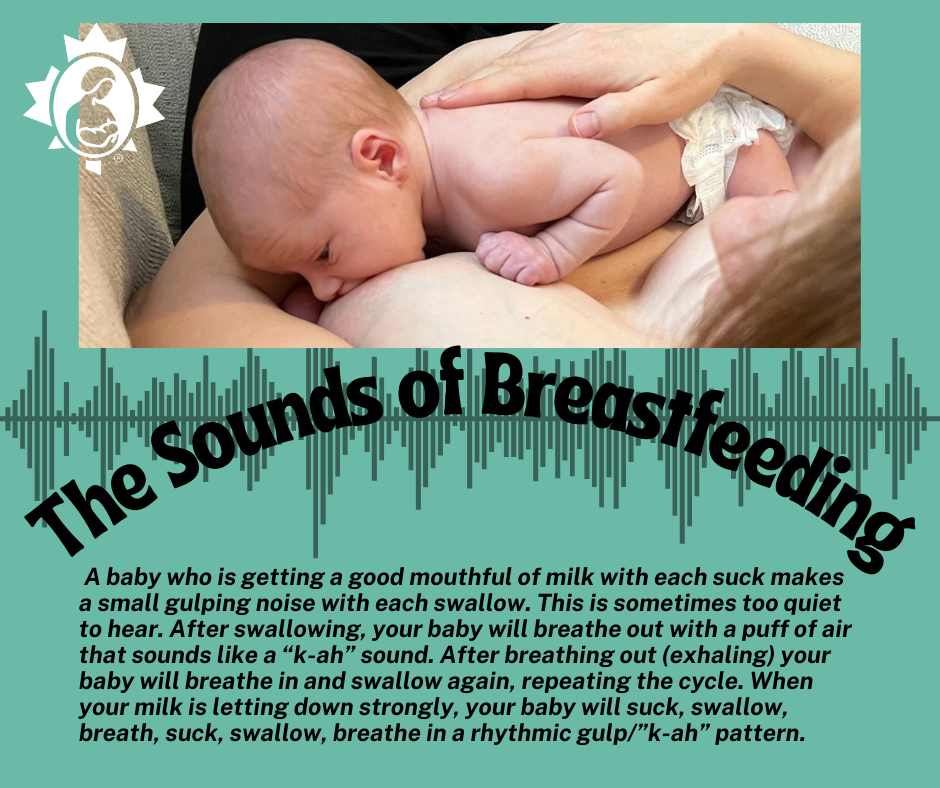
First time parents are often surprised by the feeding noises that come with nursing a baby. Breastfeeding and parenting books don’t usually mention these sounds. Photos are silent and many expectant parents have never spent time with a breastfeed baby. So, what are the sounds of breastfeeding and what do they tell us?
In the first three to five days your milk volume is small to match your baby’s small tummy size. Your baby may suck several times before you hear a swallowing sound. As the milk volume increases your baby will suck rapidly at the beginning of each feeding to trigger the letdown of your milk (milk ejection reflex). Once your milk starts flowing, your baby will usually suck once or twice for each swallow. A baby who is getting a good mouthful of milk with each suck makes a small gulping noise with each swallow. This is sometimes too quiet to hear. After swallowing, your baby will breathe out with a puff of air that sounds like a “k-ah” sound. After breathing out (exhaling) your baby will breathe in and swallow again, repeating the cycle. When your milk is letting down strongly, your baby will suck, swallow, breath, suck, swallow, breathe in a rhythmic gulp/”k-ah” pattern.
Sometimes you may hear a “clicking” sound. Your baby may or may not also have noticeable dimples in the cheeks with each suck. And you may have sore nipples. These signs, together or individually, may suggest that your baby has not achieved a deep latch. A “click” indicates that your baby is breaking the seal on the breast. This causes your nipple to slip in your baby’s mouth and often creates a sore nipple. If you are hearing clicking, try improving the latch by bringing your baby’s chin deeply onto your breast. Your baby’s nose should tilt away from the breast as your baby’s head tips back. The nose often touches the breast but it shouldn’t be poking into it. You shouldn’t feel like you have to hold your breast back so your baby can breathe. Chin in, nose tilting away, head back is the same position you take when you drink something. (Try it now, pretend to take a drink of water. See how your chin goes forward and your head tips back?)
When you feel that your baby is not latched well, it is important to deal with it right away. If it feels painful you may have to unlatch your baby from the breast by slipping a finger in the corner of her mouth to break the suction. Then you can try latching again. However, usually the latch can be adjusted while your baby is still latched. If your baby’s chin is tucked into her chest, she will not be able to hold onto the breast with her mouth. She will have difficulty swallowing. (Try it now. Tuck your chin into your chest and swallow. It is very hard.) You can try adjusting your baby so that her chin presses into your breast and her head tips back. In this position your baby can drink comfortably, just like you do.
If the clicking, dimpling or sore nipples persist, contact a La Leche League Leader or an International Board Certified Lactation Consultant (IBCLC) to review your latch. In most cases, an adjustment to the positioning fit between you and your baby quickly resolves the problem. Persistent soreness or poor latch may need further investigation to ensure that your baby does not have a tongue or lip tie or some other issue.
You may hear something that sounds like your milk is hitting the back of your baby’s throat, or like your baby is drowning when your milk lets down. Some mothers have a strong milk ejection reflex. This means that your baby can get a lot of milk with each suck. Your newborn may find this amount of milk hard to handle. This may make your baby pull away from the breast when the flow is strongest. Adjusting your position so you are laying back with your baby on top of your breast can help manage the milk flow. This is another situation in which a La Leche League Leader can help you work out the best positioning for you and your baby.
Sometimes babies make grunting noises or have raspy or squeaky breathing. These sounds may be fine but you should discuss with your healthcare provider or International Board Certified Lactation Consultant (IBCLC).
The most important thing to remember is that breastfeeding should not be painful. If you are experiencing nipple pain something is not right, no matter how good the latch looks from the outside. The next thing to consider is whether or not your baby is producing adequate wet and poopy diapers for his age and is gaining weight appropriately. See How to Know Your Baby is Getting Enough Milk for more information.
If you are pain free and your baby is growing well then the noises of breastfeeding are just funny noises and you will probably learn to love them.
Please consider supporting LLLC.
Updated 2024
